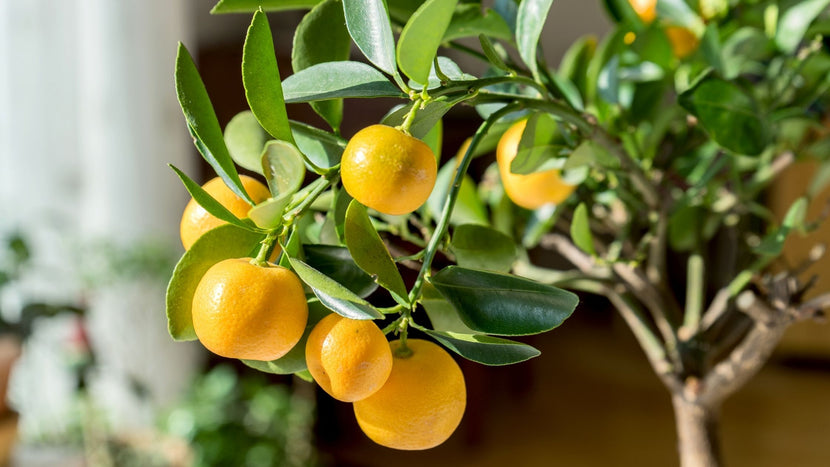How To Care For Citrus Trees
Plant Guide

Citrus Trees are loved, both for the juicy and refreshing fruit they provide and for their unique allure and flare they add to a space! Whether you choose to grow the classics like lemons and limes, or you're feeling a bit more adventurous and want to take on the sweet oranges, tangerines, and grapefruits, we have the tree for you!
Offering a wide range of citrus tree varieties available for you to grow, the team at GGD wants you to be fully prepared in the best practices of growing your sweet fruiting tree. Read on to learn how to best care for your newly planted citrus tree.
These sweet little fruit-bearing trees enjoy warm temps and heavy sun. Citrus trees make perfect patio plants and can also be grown indoors near a sunny window. No matter what tree you decide to grow, diving into the project of growing flowering and fruiting trees will be a project you surely won't regret!
Ground Rules
Light
Citrus Trees love the sun! Citrus Trees require eight to 12 hours of sunlight daily. If growing your tree indoors, we recommend you position your plants beside a south-facing window with good airflow. If necessary, supplement sun with a grow light during dark winter months.
Water
Container-grown citrus trees need more water than those planted outside.
In the spring, water two to three times a week. In the summer, as temperatures rise, your citrus tree may need to be watered daily. Keep the soil moist but not soggy.
A good indication of when you should water is to check the top 2 to 3 inches of soil. If it is dry to the touch, your lemon tree needs watering. Houses generally don't have the humidity lemon trees need to grow and bear fruit. Mist or spray your lemon tree several times a week.
Soil
Citrus Trees thrive best in lightweight and well-draining soil conditions. However, they are not too picky when it comes to most soil mixes. We recommend using Espoma Cactus Mix to provide an optimal base for your Citrus Tree to grow beautifully for years to come.
Food
We recommend feeding your indoor citrus plants with Espoma Citrus-tone. It is best to fertilize your plants by sprinkling one teaspoon of fertilizer on the soil surface per every 4 inches of pot diameter.
Apply double for pots over 12 inches. Be sure to mix the fertilizer into the top layer of soil by using a fork to gently stir the fertilizer into the top 2 inches of soil evenly. With frequent watering of potted plants, nutrients may be lost, and more frequent applications may be required. Feed every 60 days in late winter to fall.
Temperature
Citrus Trees grow best in temperatures between 60 and 90 degrees Fahrenheit. The trees are not hardy to cold temperatures, so if grown in a container outside, be sure to be mindful of cold snaps and be prepared to transport your tree indoors come fall and winter.
Toxicity
Citrus Trees are Toxic to Cats and Dogs.
Mulch
If you live in a warmer climate and decide to plant your citrus tree in the ground, we recommend mulching your tree to retain moisture and protect the roots. To mulch your Citrus Tree, simply add a 2 to 3 inch layer of mulch around the base of the plant.
Planting Process
- Once you have taken your citrus tree out of the box, remove all excess packaging and choose a sunny location!
- Prep your soil. Citrus trees prefer a loamy soil that is well draining and contains rich organic matter.
- Dig a hole that is one foot larger than the root ball.
- Prep the root ball and place your tree in the hole. Back fill the hole until root ball is completely covered.
- Water your young tree thoroughly!
Types of Citrus Trees and Their Fruit Flavors
| Citrus Tree | Flavor of Fruit |
|---|---|
| Meyer Lemon Tree | Sweet, somewhat floral-tasting lemons. Less tangy than your typical Lemon! |
| Ponderosa Lemon Tree | Highly acidic, tangy flavor with a subtle sweetness |
| Key Lime Tree | Mildly tart and bitter |
| Persian Lime Tree | Distinctively tart and bitter |
| Kieffer Lime Tree | Tangy and aromatic! |
| Calamondin Orange Tree | Mellow flavor and subtle hints of tang |
| Red Navel Orange Tree | Hints of strawberry and rose in this uniqely low-acidic orange |
| Owari Satsuma Mandarin Tree | Mild, sweet and seedless! |
| Sunburst Tangerine Tree | Rich flavor that is extremely sweet |
| Dancy Tangerine Tree | Sweet and tart with hints of spice |
| Orlando Tangelo Tree | sugary sweet cross of a grapefruit and a tangerine |
| Arctic Frost Tangerine Tree | sweet and tart with a true citrus flavor |
| Rio Red Grapefruit Tree | especially sweet and vibrant for a grapefruit |
